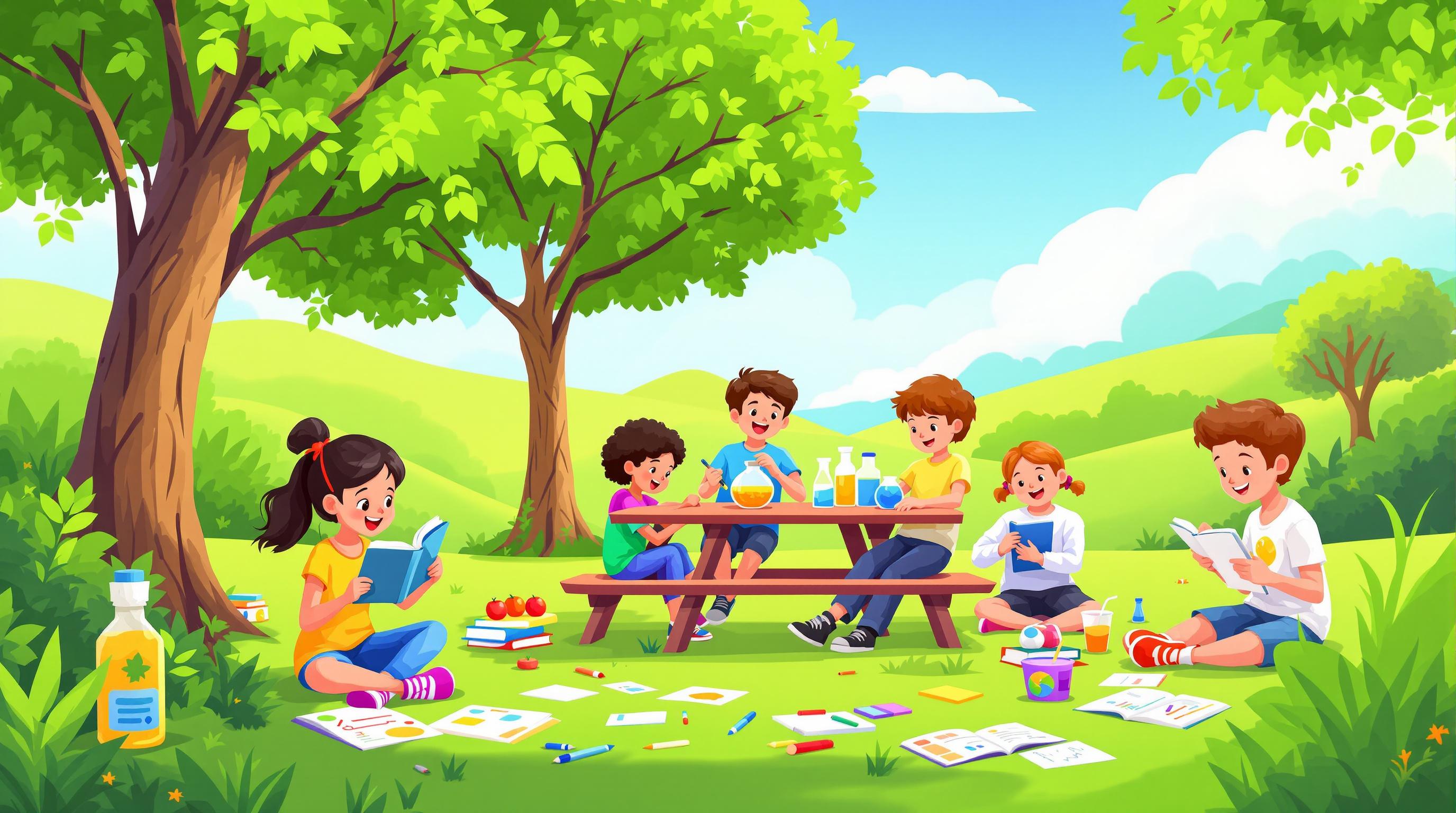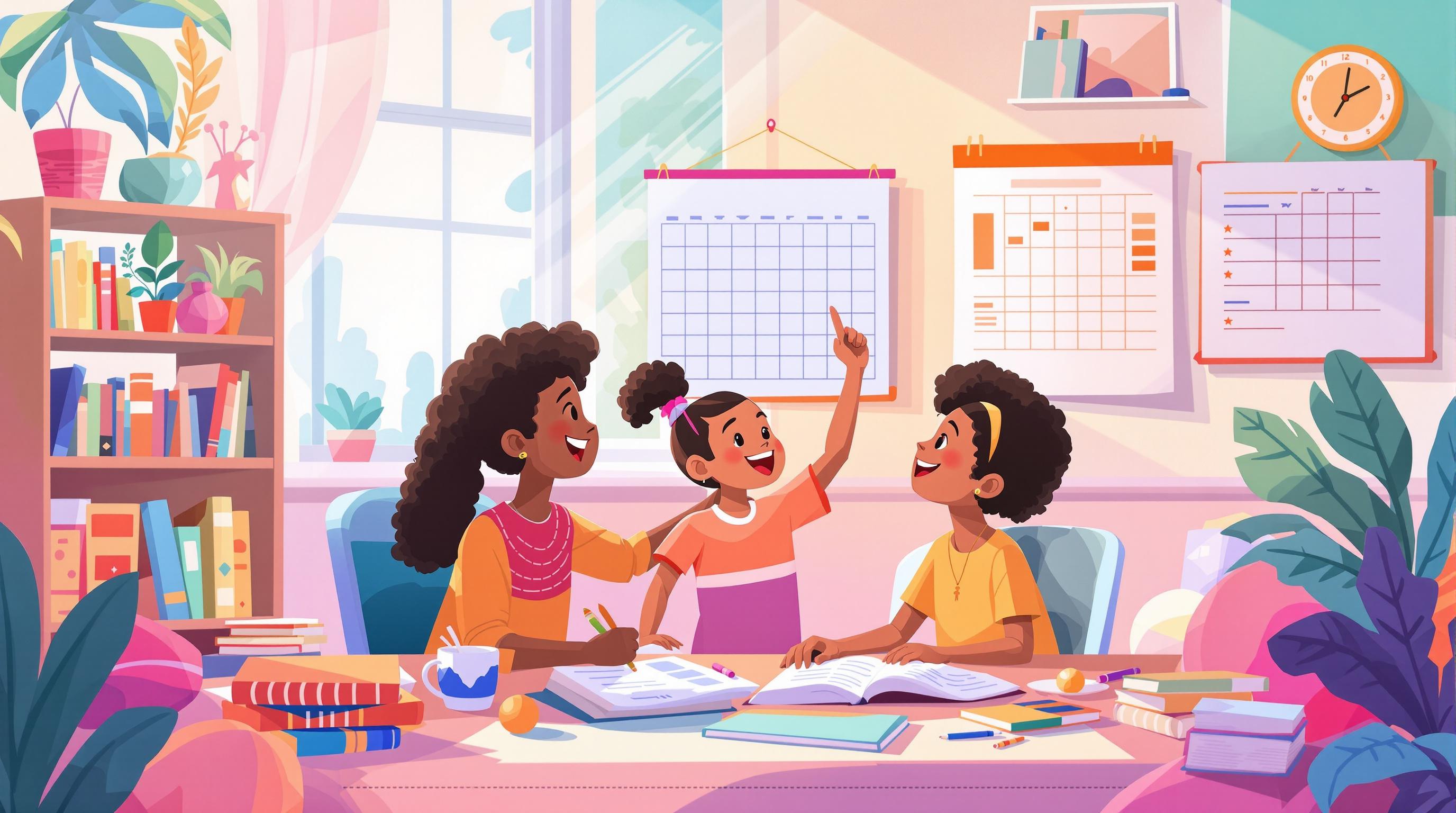Choosing between Montessori and Charlotte Mason boils down to your child’s learning style and your family’s priorities. Here’s a quick breakdown:
- Montessori: Focuses on independence, hands-on activities, and self-paced learning in a structured environment. Best for children who enjoy working independently and thrive with tactile tools.
- Charlotte Mason: Centers on literature, nature exploration, and character development with short, structured lessons. Ideal for kids who love stories, outdoor activities, and a routine.
Quick Comparison
| Aspect | Montessori | Charlotte Mason |
|---|---|---|
| Teaching Style | Guide and observer | Active guidance and correction |
| Lesson Format | Long work periods (up to 3 hours) | Short lessons (under 20 minutes) |
| Learning Materials | Montessori-specific tools | Living books and natural objects |
| Assessment Method | Observation-based, no formal tests | Informal narration and discussions |
| Environment Focus | Indoor, prepared environment | Mix of indoor and outdoor learning |
| Character Development | Practical life activities | Literature and habit formation |
Both methods offer unique strengths, and many families combine elements from both to suit their child’s needs. Whether you prioritize independence or a love for literature, these approaches provide valuable tools for homeschooling success.
Charlotte Mason vs Montessori Education: Homeschool SHOWDOWN

Differences Between Montessori and Charlotte Mason
The Montessori and Charlotte Mason methods take different paths in education, each built on its own philosophy and approach.
Montessori: Learning Through Exploration
The Montessori method is known for its unique materials that build sensory skills and practical abilities [1]. Teachers serve as guides, stepping back to let children explore freely during long, uninterrupted work periods - sometimes lasting up to three hours [2].
Children move at their own pace in a space designed to inspire curiosity, focus, and self-discipline. Materials are thoughtfully organized by subject and placed at a child-friendly height, making it easier for kids to learn independently [1][3].
Charlotte Mason: A Blend of Books and Nature
Charlotte Mason’s approach focuses on forming good habits and incorporating outdoor journaling into the curriculum. Lessons are short - less than 20 minutes for younger children - and led by teachers [2]. Character building and habit development are central to this method [1].
Nature study is a key feature, encouraging children to spend time outdoors and keep nature journals. This hands-on interaction with the natural world sharpens their observational skills while fostering a connection to their surroundings [1][2].
Comparison Chart
| Aspect | Montessori | Charlotte Mason |
|---|---|---|
| Teaching Style | Guide and observer; minimal intervention | Active guidance and correction |
| Lesson Format | Long work periods (up to 3 hours) | Short lessons (under 20 minutes) |
| Learning Materials | Montessori-specific tools | Living books and natural objects |
| Assessment Method | Observation-based; no formal tests | Informal narration and discussions |
| Environment Focus | Indoor, prepared environment | Mix of indoor and outdoor learning |
| Character Development | Practical life activities | Literature and habit formation |
Montessori leans heavily on independence, structured materials, and self-paced learning. In contrast, Charlotte Mason emphasizes well-rounded growth through literature, nature, and character development [1][2]. These differences can guide families in selecting the approach that best suits their values and their child's unique learning style.
Choosing the Right Approach
Now that we've covered the main differences, let's talk about how to pick the best option for your child and family.
Your Child's Learning Style
Understanding how your child learns can help you decide on the right method. Here’s a quick guide:
| Child's Preferences | Recommended Method |
|---|---|
| Enjoys working independently | Montessori – Encourages self-directed activities with extended focus periods |
| Thrives with structure and routine | Charlotte Mason – Provides short, focused lessons (around 20 minutes) |
| Learns best through hands-on activities | Montessori – Focuses on tactile, practical learning experiences |
| Loves stories and literature | Charlotte Mason – Relies on rich, narrative-based learning through “living books” |
| Prefers outdoor activities | Charlotte Mason – Incorporates nature studies and outdoor exploration |
| Shows strong self-motivation | Montessori – Lets children choose tasks based on their interests |
Family Values and Goals
Your family's priorities and long-term goals are just as important as your child's preferences. Think about what aligns best with your values:
- Montessori focuses on independence and practical skills, using carefully prepared environments to guide learning.
- Charlotte Mason emphasizes character development and a love for literature, with a strong connection to nature and storytelling.
Also, consider your daily routine. If you can dedicate longer, uninterrupted blocks of time, Montessori’s three-hour work periods might work well. On the other hand, if you need more flexibility, Charlotte Mason’s shorter lessons could fit better into your schedule.
Remember, you don’t have to stick rigidly to one method. Many families mix elements of both approaches to create a system that works best for them. The ultimate goal is to build a learning environment where your child thrives while staying true to your family's values and goals.
Once you’ve chosen an approach, look for resources to help you get started on your homeschooling journey.
sbb-itb-fb77983
Resources for Homeschooling
Having the right resources can make all the difference when setting up an effective homeschooling environment. Below is a quick guide to essential materials for popular methods and where to find them:
| Method | Essential Materials | Where to Find |
|---|---|---|
| Montessori | Sensory tools, practical life items, math manipulatives | Educational suppliers, libraries, and stores specializing in Montessori tools and living books |
| Charlotte Mason | Living books, nature journals, art supplies | Libraries, second-hand bookshops, and art supply stores |
| Both Methods | Educational guides, curriculum planners, assessment tools | Online platforms and homeschool communities |
A great way to enhance your homeschooling journey is by blending these methods. For example, you can pair Montessori's hands-on learning tools with Charlotte Mason's emphasis on literature and nature study. This mix gives you the freedom to design a learning experience tailored to your child’s interests and needs.
Homeschool Directory

The Homeschool Directory is a fantastic resource for finding curriculum guides, materials, and community connections. Whether you’re starting with Montessori’s tactile tools or Charlotte Mason’s focus on books and nature, the directory can help you locate resources that fit your chosen approach - or even combine elements from both.
Specialized suppliers, libraries, and homeschool platforms are great places to find Montessori and Charlotte Mason materials. With the right tools in hand, you’ll be ready to create a learning environment that works for your family.
Conclusion: Selecting the Best Method for Your Family
Deciding between Montessori and Charlotte Mason comes down to understanding your child's learning style and your family's educational priorities. Montessori's self-paced, hands-on approach works well for families who value practical skills and sensory learning. On the other hand, Charlotte Mason emphasizes literature, nature, and character-building, making it a great fit for those looking for a well-rounded, arts-focused education.
Think About Your Child's Learning Style: Does your child prefer exploring and learning independently? Montessori might be the way to go. If they thrive on structure and enjoy literature-based lessons, Charlotte Mason could be a better match.
Match with Your Family's Values: Consider what matters most to your family. Are you looking to encourage independence and practical skills? Montessori might align with your goals. If fostering a love for books and nature is a priority, Charlotte Mason could be the better fit.
Mix and Match: You don’t have to stick rigidly to one method. Many families blend aspects of both approaches, like incorporating Montessori's hands-on tools with Charlotte Mason's focus on nature and literature, to create a personalized learning plan.
Take the First Step: Resources like the Homeschool Directory and educational suppliers can help you get started. Focus on the core principles of your chosen method and build a learning environment that works for your family.
The key is to adapt these methods to suit your unique needs. The goal isn’t to follow any approach perfectly but to create a space where your child can flourish using the ideas that resonate most with your family.
FAQs
Montessori focuses on learning through physical interaction in thoughtfully arranged spaces and using hands-on materials. Children engage with sensory activities and practical tasks, while teachers act as guides, observing and supporting their independent learning journey [1][2].
Charlotte Mason, on the other hand, highlights:
- Living books: High-quality literature that inspires and educates
- Nature studies: Observing and learning from the natural world
- Character development: Building moral and ethical values
- Short, structured lessons: Keeping lessons concise to maintain focus
- Active teacher involvement: Teachers play a key role in guiding and engaging students [1][3]
Assessment and Structure
In Montessori, progress is tracked through teacher observation rather than formal tests. The focus is on hands-on learning in a prepared environment. Charlotte Mason prioritizes literature and nature-based learning, using narration and discussions as alternatives to traditional assessments [1].
The two methods also differ in scheduling. Montessori offers flexible, child-led schedules with extended work periods. In contrast, Charlotte Mason follows a more structured routine, emphasizing short, focused lessons [2].
Combining Methods
Blending these approaches can be effective. For instance, you could:
- Introduce Montessori materials to teach practical skills
- Add Charlotte Mason's nature studies and use her recommended living books
- Combine Montessori's hands-on activities with Charlotte Mason's focus on character development [1][3]
Discipline Approaches
Montessori promotes self-discipline through internal motivation, encouraging children to take responsibility for their actions. Charlotte Mason supports discipline by teaching good habits and using appropriate consequences when needed [2].
These strategies allow families to select or merge methods in ways that suit their individual needs and goals.


